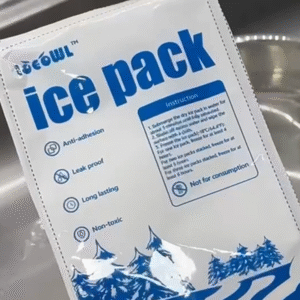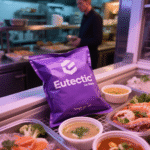Why Choose a Laboratory Dry Ice Pack Sheet?
Einführung: A laboratory dry ice pack sheet is more than a cold pad—it’s a safety tool that keeps lab specimens frozen at ultra low temperatures. Im Gegensatz zu Gelpackungen, these sheets encapsulate dry ice that sublimates at –78.5 °C (–109,3 °F) without leaving water, protecting samples from thawing and contamination. You’ll learn how the sheets work, why they’re safer and greener than loose pellets, and how to use them effectively in 2025’s evolving cold chain logistics. This article uses clear language and real world examples to help you choose, handle and optimize your laboratory dry ice pack sheet.
Understand how laboratory dry ice pack sheets work and why their three layer design outperforms gel packs.
Select the right laboratory dry ice pack sheet by considering size, cell count and phase change materials (PCMs).
Learn safety and regulatory requirements for shipping dry ice, including labeling, ventilation and protective equipment.
Compare laboratory dry ice pack sheets with gel packs and other coolants to identify the best solution for your samples.
Erkunden 2025 innovations and trends—smart sensors, AI optimized logistics and sustainable materials—that are reshaping cold chain shipping.
What Is a Laboratory Dry Ice Pack Sheet and Why Is It Unique?
Direkte Antwort: A laboratory dry ice pack sheet is a flexible pad containing sealed pockets of dry ice or PCM gel that provide ultra cold temperatures. Unlike loose dry ice pellets, the sheet’s multi layer design slows sublimation and spreads cold evenly. This means your samples stay frozen without water residue. The sheet format also makes handling safer by reducing direct contact with dry ice, which can cause cold burns.
Erweiterte Erklärung: Each sheet is engineered with three key layers: a protective outer shell (often polyethylene or PET) that prevents punctures and contains CO₂ gas; A gel or PCM layer that stores latent heat and moderates the release of cold; und a dry ice core that provides temperatures as low as –78.5 °C. When the dry ice sublimates to gas, the PCM layer slows the process, ensuring consistent cooling for 12–48 hours or longer depending on the sheet size. Because sublimation produces CO₂ gas rather than liquid water, the sheet leaves no moisture and reduces contamination risk.
Key Components of Laboratory Dry Ice Pack Sheets
Detailed understanding of the sheet’s layers helps you appreciate why it’s superior to simple gel packs.
| Komponente | Beschreibung | Benefit to your samples |
| Gel or PCM layer | Flexible material surrounding the dry ice core that stores latent heat | Slows sublimation and spreads cold evenly, preventing hot spots and sample damage |
| Dry ice core | Solid CO₂ providing ultra low temperatures (–78,5 °C) | Keeps vaccines, biologics or frozen specimens at deep freeze conditions for extended periods |
| Protective outer shell | Leicht, durable covering that prevents moisture ingress and contains the gas | Improves handling safety and keeps the dry ice contained so you can pack irregular shapes |
Praktische Tipps und Vorschläge
Pre condition the sheet: Soak your laboratory dry ice pack sheet in water until the cells expand, then freeze for at least 24 hours to ensure the PCM layer reaches its target temperature.
Vermeiden Sie direkten Kontakt: Place a cardboard or insulating layer between the sheet and your samples to prevent freezer burn and maintain consistent temperatures.
Combine cooling methods: For particularly sensitive samples or longer journeys, layer gel packs or phase change plates beneath the dry ice sheet for added stability.
Fall aus der realen Welt: A meal kit company replaced loose dry ice with customized 24 cell sheets. By tailoring the sheet size and cell count, they maintained –18 °C for 24 hours without water residue and reduced shipping weight by 15 %. This resulted in lower freight costs and fewer temperature excursions.
How Do You Choose the Right Laboratory Dry Ice Pack Sheet?
Direkte Antwort: Wählen Sie a laboratory dry ice pack sheet by matching it to your shipment’s temperature requirements, size and transit time. Customization options—such as sheet size, cell count and PCM type—allow you to tailor the cooling profile and minimize CO₂ off gas. Always plan for enough dry ice to last the journey plus a safety margin.
Erweiterte Erklärung: Selecting the right sheet involves assessing several variables. Sheet size and shape should match your packaging dimensions; common formats include 18×12 cm or 28.5×25 cm sheets. Cell count and geometry affect flexibility—9 cells (3×3) are suitable for small boxes, während 24 Zellen (4×6) wrap around irregular items. Phasenwechselmaterialien determine the temperature range: some gel dry ice packs reach –123 °C when frozen, while dry ice replacement packs maintain –21 °C. You can also choose eco friendly outer materials, such as biodegradable films, and add custom branding.
When estimating the amount of dry ice needed, follow the rule of thumb: for overnight shipments, use half the weight of your payload in dry ice; equal weight will keep the product frozen for up to 48 Std., and one and a half times the weight covers 72 Std.. Zusätzlich, incorporate transit conditions Und Produktempfindlichkeit—pharmaceuticals may require –70 °C, while some food items need only –18 °C.
Choosing Parameters Table
| Parameter | Typical options | How it affects your shipment |
| Sheet size | 18×12 cm, 20×15 cm, 28.5×25 cm, Brauch | Fits container footprint, maximizes surface contact and reduces empty space |
| Zellzahl | 9 Zellen (3×3), 12 Zellen (2×6), 24 Zellen (4×6) | More cells mean greater flexibility; wrap around irregular items |
| PCM type | Gel, Eutektische Platten, cryogenic gel | Determines temperature range; gel dry ice packs can reach –123 °C, replacement packs maintain –21 °C |
| Außenmaterial | PE/PET, non woven fabric, biodegradable film | Influences durability, condensation control and sustainability |
Praktische Tipps und Vorschläge
Pre plan for transit time: Estimate how long your specimens will be in transit and choose a sheet with enough dry ice to last that duration plus a buffer.
Layer thoughtfully: For ultra cold applications, layer a gel pack beneath your dry ice sheet and consider adding a cardboard spacer to stabilize temperature.
Consider branding: Custom printing and biodegradable films enhance brand recognition and support sustainability goals.
Fallbeispiel: Laboratory researchers shipping enzyme samples overseas used customized 12 × 6 cell sheets combined with eutectic plates. The hybrid configuration maintained –70 °C for 48 hours without leaks and complied with hazardous materials regulations, reducing paperwork while ensuring sample integrity.
What Safety and Regulatory Guidelines Govern Dry Ice Pack Sheets?
Direkte Antwort: Trockeneis wird als klassifiziert als Klasse 9 Gefahrgut (Und 1845), so laboratories must follow specific packaging, labeling and handling regulations. Packages must vent CO₂ gas to prevent explosion, display hazard labels and UN 1845 identification, and include the net weight of dry ice. Handlers must wear insulated gloves and goggles to avoid cold burns.
Erweiterte Erklärung: Die USA. Department of Transportation and the International Air Transport Association regulate dry ice shipments. Hazard classification and training: Dry ice’s proper shipping name is Trockeneis oder Kohlendioxid, solide, Und 1845. Employees must complete hazardous materials training. Verpackungsanforderungen: Use durable outer packaging with insulation (fiberboard, plastic or wooden boxes) and avoid sealed containers to prevent pressure build up. A layer of Styrofoam within a box provides insulation but must not be airtight. Labeling and documentation: Mark packages with the proper shipping name, UN -Nummer, net quantity of dry ice and the shipper and recipient addresses. For shipments exceeding 5.5 Pfund (2.5 kg), Title 49 CFR regulations apply.
Safety precautions: Dry ice sits at –109 °F and can cause frostbite; always wear insulated gloves and face protection. Work in a well ventilated area because CO₂ gas can displace oxygen and cause suffocation. Do not store dry ice in confined spaces or sealed containers—one pound can produce about 250 liters of CO₂ gas, which may cause an explosion. Allow leftover dry ice to sublimate in a ventilated area and never dispose of it in sinks or trash bins.
Handling and Disposal Best Practices
Follow these guidelines to keep yourself and others safe when using a laboratory dry ice pack sheet.
| Practice | Reason | Nutzen |
| Tragen Sie isolierte Handschuhe und Augenschutz | Dry ice’s extreme cold can burn skin | Prevents frostbite and eye injuries |
| Lagerräume lüften | CO₂ gas can accumulate and displace oxygen | Reduces risk of suffocation |
| Use vented containers | Sealed containers may explode due to pressure build up | Protects packaging and handlers |
| Beschriften Sie Pakete deutlich | Regulations require UN 1845 and net weight markings | Ensures compliance and facilitates emergency response |
| Dispose properly | Let unused dry ice sublimate; never discard in drains | Prevents damage to plumbing and infrastructure |
Praktische Tipps und Vorschläge
Trainiere dein Team: All laboratory staff involved in packing or shipping dry ice must receive hazardous materials training.
Document shipments: Prepare an air waybill or commercial invoice listing UN 1845, net weight and number of packages when shipping internationally.
Belüftung planen: When transporting specimens in a car or van, ensure there’s ventilation; never leave dry ice in a sealed trunk.
Real world caution: A laboratory worker suffered frostbite after handling dry ice without gloves. The University of Rochester’s safety manual notes that dry ice can burn skin in seconds and warns to never submerge your head into a cooler because CO₂ vapors settle in low spaces. Always use tongs or tools and work in open areas.
How Do Laboratory Dry Ice Pack Sheets Compare With Gel Packs and Other Coolants?
Direkte Antwort: Laboratory dry ice pack sheets deliver ultra low temperatures (–78,5 °C) for 24–48+ hours without moisture, making them ideal for specimens requiring deep freeze conditions. Gel packs and water based cold packs maintain around 0 °C and are better for chilled shipments. Unlike dry ice sheets, gel packs may leak when thawed and cannot maintain sub zero temperatures.
Erweiterte Erklärung: Dry ice pack sheets encapsulate CO₂ to keep products deeply frozen; they leave no liquid residue and offer controlled sublimation. Loose dry ice pellets can provide similar temperatures but are difficult to handle and require more ventilation. Gel packs have a phase change at 0 °C (32 ° F) and gradually warm, making them suitable for vaccines that need 2–8 °C or foods that should stay above freezing. Reusable cold packs are durable but require return logistics and cleaning.
Cooling Solutions Comparison Table
| Cooling solution | Temperaturbereich & Dauer | Liquid residue | Typical applications |
| Dry ice pack sheet | –109 °F to –4 °F (–78.5 °C to –20 °C) für 24–48 Stunden | Keiner | Ultra frozen shipments (Impfungen, Biologika, gefrorenes Essen) |
| Loose dry ice pellets | –109 °F to –4 °F for 24–72 h | Keiner | Bulk shipments requiring longer durations |
| Gelpackungen | 32 °F to 41 ° F (0 ° C bis 5 °C) for 12–48 h | Ja | Pharmaceuticals requiring chilled conditions, verderbliche Lebensmittel |
| Phase change material (PCM) Packungen | Customizable range –5 °F to 20 °F for 24–96 h | May contain liquid | Specialty shipments needing specific cold ranges |
Praktische Tipps und Vorschläge
Match coolant to product: Use dry ice pack sheets for deep freeze samples like cell therapies and cryogenic reagents, gel packs for chilled vaccines and perishable foods.
Combine when necessary: Hybrid cooling setups pair gel packs with dry ice to extend duration and moderate temperature swings.
Consider disposal: Gel packs may leak water and require cleanup; dry ice sheets sublime cleanly but are hazardous materials.
Illustrative example: A clinical trial shipped gene therapy vials on dry ice sheets at –70 °C. When the client switched to gel packs for a later shipment, the vials experienced thawing and lost potency. The trial resumed dry ice sheets to maintain sample integrity, highlighting the importance of matching coolant to product requirements.
2025 Developments and Trends in Laboratory Dry Ice Pack Sheets
Trendübersicht: The cold chain industry is rapidly evolving. The global dry ice market is growing at roughly 5 % pro Jahr, while CO₂ supply increases by only 0.5 %, leading to shortages and price spikes up to 300 %. To meet demand, manufacturers are creating customizable dry ice pack sheets with smart sensors and AI optimized logistics. Nachhaltige Materialien, such as biodegradable films and reusable PCMs, reduce environmental impact and support circular economy goals.
Neueste Fortschritte auf einen Blick
AI enabled route optimization: Advanced algorithms analyze weather, route and shipment data to reduce transit times and minimize dry ice consumption, lowering CO₂ emissions.
Intelligente Sensoren: Embedded temperature and CO₂ sensors provide real time monitoring, alerting you when sublimation rates change so that you can replenish or adjust cooling.
Hybridkühlsysteme: Combining dry ice sheets with PCMs and gel packs creates stable temperature profiles while using less dry ice.
Nachhaltige Materialien: New sheets use biodegradable outer films and recyclable components, aligning with industry pressure to cut emissions and reduce waste.
Marktwachstum: The cold chain logistics industry is projected to reach US$372 billion by 2029, driven by demand for pharmaceuticals, biologics and frozen foods.
Markteinsichten: Rising demand for biologics and precision medicine is driving the need for ultra cold transport solutions. Jedoch, CO₂ shortages mean dry ice is becoming more expensive, pushing laboratories to optimize shipments and adopt hybrid solutions. Regulatory bodies are updating guidance to reflect new materials and data logging requirements. Companies that embrace AI and sustainable packaging will gain competitive advantage and reduce their carbon footprint.
Häufig gestellte Fragen
Q1: Is a laboratory dry ice pack sheet safe for domestic shipments?
Yes—when properly packed. Ensure that the sheet is placed inside a vented insulated container, label it with UN 1845 und das Nettogewicht von Trockeneis, and leave space for gas to escape. Handle the sheet with insulated gloves and keep it away from children or pets.
Q2: Can I reuse a laboratory dry ice pack sheet?
Some sheets are reusable if they are designed with durable outer shells and refillable PCMs. Jedoch, many single use sheets are intended for one trip. Always check the manufacturer’s specifications. Reusing a sheet beyond its recommended lifespan can compromise cooling performance and violate safety regulations.
Q3: Wie soll ich übrig gebliebenes Trockeneis entsorgen??
Allow the dry ice to sublimate in an open, ventilated area and never dispose of it in sinks or trash bins. Do not place it in sealed containers or near combustible materials. Once fully sublimated, recycle or dispose of the outer sheet according to local regulations—some materials are biodegradable.
Q4: What if my shipment contains less than 5.5 Pfund Trockeneis?
Non medical shipments under 5.5 Pfund (2.5 kg) require minimal packaging markings but must still display the proper shipping name and UN 1845. Always verify current regulations and carrier policies.
Q5: Can I combine gel packs with a laboratory dry ice pack sheet?
Ja. Combining gel packs with dry ice sheets can slow sublimation and extend cooling duration. Place the gel packs around your sample to buffer temperature changes, then add the dry ice sheet above or around the gel.
Zusammenfassung und Empfehlungen
Zusammenfassung: Laboratory dry ice pack sheets encapsulate dry ice within a multi layer pad that slows sublimation, maintains ultra low temperatures and prevents moisture. Customization options—sheet size, Zellzahl, PCM type and outer material—help you tailor the sheet to your shipment. Proper handling requires training, ventilation and labeling because dry ice is regulated as a hazardous material. Compared with gel packs, dry ice sheets deliver deeper cold without leaks and are ideal for ultra frozen specimens. 2025 trends show growth in AI optimized logistics and sustainable materials.
Umsetzbarer Rat:
Assess your shipment: Determine required temperature range, duration and sensitivity.
Select the right sheet: Choose a laboratory dry ice pack sheet with appropriate size, cell configuration and PCM. Pre condition it by soaking and freezing.
Pack safely: Use vented, Isolierte Behälter, wear protective gear and leave room for CO₂ gas to escape. Label packages properly and include documentation.
Explore hybrid solutions: Combine dry ice sheets with gel or PCM packs to extend cooling and reduce dry ice consumption.
Bleib informiert: Monitor 2025 innovations—smart sensors, AI and sustainable materials can improve efficiency and reduce environmental impact.
Über Tempk
Company background: Tempk is a leading innovator in cold chain packaging, offering a range of ice packs, insulated bags and customized laboratory dry ice pack sheets. Our products are engineered with advanced phase change materials and eco friendly films to deliver consistent ultra cold temperatures while minimizing CO₂ emissions. We maintain rigorous quality standards, hold Sedex certification and invest heavily in R&D.
Unsere Vorteile: We offer customizable sheet sizes, cell counts and PCM formulations to match your specific shipment needs. Many of our dry ice pack sheets can be rehydrated and reused, Abfall reduzieren. We also provide technical guidance and simulation tools to calculate the exact amount of dry ice required, helping you plan cost efficient shipments.
Aufruf zum Handeln: Ready to optimize your cold chain logistics? Contact Tempk’s cold chain specialists to design a tailored laboratory dry ice pack sheet solution. Our team can help you meet regulatory requirements, reduce shipping costs and protect your valuable specimens. Reach out today for a consultation and start shipping smarter.
























